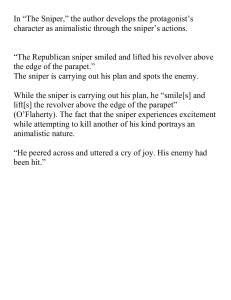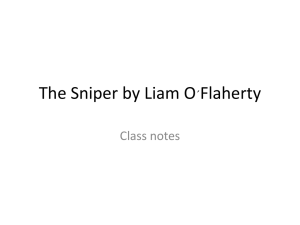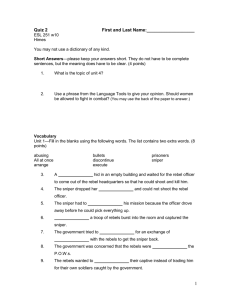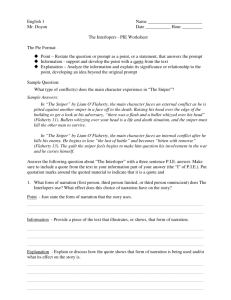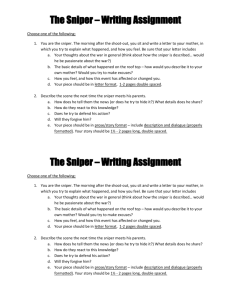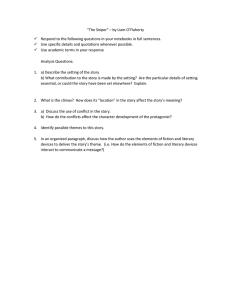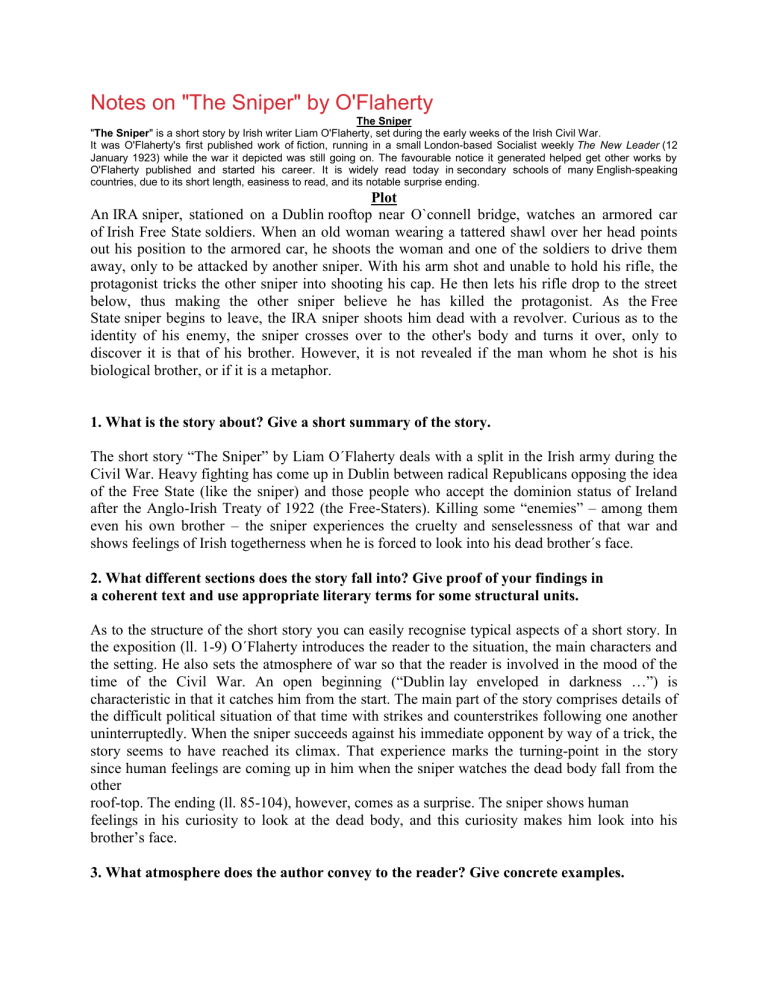
Notes on "The Sniper" by O'Flaherty The Sniper "The Sniper" is a short story by Irish writer Liam O'Flaherty, set during the early weeks of the Irish Civil War. It was O'Flaherty's first published work of fiction, running in a small London-based Socialist weekly The New Leader (12 January 1923) while the war it depicted was still going on. The favourable notice it generated helped get other works by O'Flaherty published and started his career. It is widely read today in secondary schools of many English-speaking countries, due to its short length, easiness to read, and its notable surprise ending. Plot An IRA sniper, stationed on a Dublin rooftop near O`connell bridge, watches an armored car of Irish Free State soldiers. When an old woman wearing a tattered shawl over her head points out his position to the armored car, he shoots the woman and one of the soldiers to drive them away, only to be attacked by another sniper. With his arm shot and unable to hold his rifle, the protagonist tricks the other sniper into shooting his cap. He then lets his rifle drop to the street below, thus making the other sniper believe he has killed the protagonist. As the Free State sniper begins to leave, the IRA sniper shoots him dead with a revolver. Curious as to the identity of his enemy, the sniper crosses over to the other's body and turns it over, only to discover it is that of his brother. However, it is not revealed if the man whom he shot is his biological brother, or if it is a metaphor. 1. What is the story about? Give a short summary of the story. The short story “The Sniper” by Liam O´Flaherty deals with a split in the Irish army during the Civil War. Heavy fighting has come up in Dublin between radical Republicans opposing the idea of the Free State (like the sniper) and those people who accept the dominion status of Ireland after the Anglo-Irish Treaty of 1922 (the Free-Staters). Killing some “enemies” – among them even his own brother – the sniper experiences the cruelty and senselessness of that war and shows feelings of Irish togetherness when he is forced to look into his dead brother´s face. 2. What different sections does the story fall into? Give proof of your findings in a coherent text and use appropriate literary terms for some structural units. As to the structure of the short story you can easily recognise typical aspects of a short story. In the exposition (ll. 1-9) O´Flaherty introduces the reader to the situation, the main characters and the setting. He also sets the atmosphere of war so that the reader is involved in the mood of the time of the Civil War. An open beginning (“Dublin lay enveloped in darkness …”) is characteristic in that it catches him from the start. The main part of the story comprises details of the difficult political situation of that time with strikes and counterstrikes following one another uninterruptedly. When the sniper succeeds against his immediate opponent by way of a trick, the story seems to have reached its climax. That experience marks the turning-point in the story since human feelings are coming up in him when the sniper watches the dead body fall from the other roof-top. The ending (ll. 85-104), however, comes as a surprise. The sniper shows human feelings in his curiosity to look at the dead body, and this curiosity makes him look into his brother’s face. 3. What atmosphere does the author convey to the reader? Give concrete examples. The atmosphere in “The Sniper” is characterised by one of the darkest chapters in Irish history, i.e. Civil War. Therefore, the reader is closely confronted with the succession of bullets and machine guns being fired and armoured cars driving in the streets of Dublin. On the one hand scenes of action and reaction to heavy firing are alternating very fast. O’Flaherty’s choice of words underlines the effect in a very impressive way, with many onomatopoeic words appearing in the story (such as “flash”, “whizzed”, “pierce the steel grey monster”, “clattered”, “crumpled up”, “dull thud” or “shattered mass”. On the other hand there is a strong contrast to words of silence used as well. The author emphasizes the stillness noticeable in pauses of shooting or in dead bodies lying “still” on the ground. Silence is always tricky in times of war, and so the word “still” almost acquires an ambiguous meaning. All in all, the reader notices a rather serious and sinister atmosphere, only at the end of the story a ray of hope does shine through. 4 Characterize the sniper. What do we get to know about his feelings? The narrator in the story calls the sniper “young”, “ascetic” and “fanatic” in the exposition. He is a soldier who has to carry out his orders of killing his enemies in cold blood, without any feelings of guilt or remorse. To show pain is forbidden. The sniper plans his actions minutely and is presented by the narrator as a watchful and diligent observer of the opponents´ next steps. Being very courageous and obedient, he takes his own death into account in order to fulfil his tasks. After being hit by the enemy sniper, he has to think of a trick to be successful at last. Consequently, feelings of superiority are coming up, he can smile again (l. 69), is eager to kill the other sniper (l. 72) and utters “a cry of joy” (l. 76f) after his success. Yet after that immediate experience of death he shudders, has lost all the eagerness for another fight, and is “bitten by remorse” (l. 84f). At the end of this inner process of revolt (l. 87) the protagonist´s conscience wins, he regrets being involved in that war (“cursing the war, cursing himself, cursing everybody” and feels guilty. The author O´Flaherty has the sniper look into his brother´s face at the end of the story which is certainly the most effective ending you can imagine. “The Sniper” can, therefore, rightly be called a story of initiation because a young man is introduced to the world of adults when he is confronted with the implications of his cruel actions in war. 5 Describe the point of view used in the story very briefly. The perspective is that of a 3rd person narrator. The point of view is limited because the narrator confines himself to the protagonist’s point of view. That is to say that he limits his narration to what is experienced, thought, and felt by the sniper who is in the centre of attention in the action and thus provides the “centre of consciousness”. The narrator knows exactly what the protagonist is going to do next and observes him with a “camera-eye” technique. Consequently, the reader feels deeply with the protagonist and his situation. Who else but an omniscient narrator could know that “his [the sniper’s] eyes had the cold gleam of the fanatic” , that they are “the eyes of a man who is used to look at death” , and that “he must kill that enemy” . The text abounds in countless examples of the Republican’s thoughts and feelings, almost culminating in self-denial. 6. If you consider the historical background against which the story is to be seen, can you imagine any relationship to Bernard MacLaverty´s novel “Cal”? As to its relationship with Bernard MacLaverty´s novel “Cal”, we can recognize quite a number of similarities. For example, both literary pieces deal with the fight for political purposes and the harsh realities of war. Cal´s personal relationship to Marcella is overshadowed by his involvement in IRA actions that have led to the murder of her husband. Consequently, Marcella will never be able to respond to his signs of love. Cal, on the other hand, has scruples of showing his real identity and will never succeed in courting her effectively. However, he wants to leave the IRA, take responsibility, and lead a decent life. The Republican, although called “sniper” only, is also an individual who develops human qualities from his actions. So the two works can indeed be compared. Yet there are differences as well. The novel presents the political troubles in Northern Ireland during the 1970s whereas the short story deals with the troubles in Dublin after the Proclamation of the Free State in 1921. One question remains open at the end of the story: Will the sniper also take responsibility for his actions as Cal does at the end of the novel when he is almost relieved after his arrest by the police? A Brief Analysis of the Story Type of Work and Year of Publication .......“The Sniper,” Liam O'Flaherty's first published work, is a short story. It was printed in London in the January 12, 1923, issue of a weekly socialist publication, The New Leader. Setting ......."The Sniper" takes place in Ireland's largest city, Dublin, on the country's east coast on Dublin Bay, an inlet of the Irish Sea. The time is nightfall in June after the establishment of the Irish Free State in 1922. The sniper posts himself on a rooftop in central Dublin near the Four Courts building, which houses the high courts of Ireland, and O'Connell Bridge, which spans the River Liffey. The Liffey divides the city into two sections as it runs eastward to Dublin Bay. Characters IRA Sniper: Man posted on a roof in Dublin. Opposing Sniper: Enemy gunman posted on a roof across from the IRA sniper. Turret Gunner: Man shot by the IRA sniper. Old Woman: Informer who betrays the position of the IRA sniper to the turret gunner. Unseen Machine Gunner: Person who fires at the IRA sniper after the latter leaves the roof. Point of View .......O'Flaherty wrote "The Sniper" in limited third-person point of view, in which he presents the thoughts of the IRA sniper but does not present the thoughts of any other character. He wrote "The Sniper" while Ireland was embroiled in sectarian conflict. . Historical Background .......In 1919, the newly formed Irish Republican Army launched guerilla warfare during the Irish War of Independence to liberate Ireland from the British. Unable to contain the rebels, London agreed in the 1921 Anglo-Irish Treaty to create an Irish Free State. However, the agreement would recognize the Free State only as a dominion in the British Commonwealth of Nations. Moreover, it would permit six counties in Northern Ireland to withdraw from the Free State, allow the British to maintain ports in the south, and require the Free State to pay part of the debt Britain incurred in waging the war. Consequently, not all Irishmen accepted the agreement, the provisions of which became effective in 1922. (The six northern counties seceded, as expected.) Once-united Irish fighters were now split into two factions—disgruntled IRA members and supporters of the Free State—and fought a civil war. O’Flaherty, himself a member of the IRA, centers his short story on a scene of fighting in Dublin in which an IRA sniper shoots at Free Staters from a rooftop. Plot Summary At nightfall in Dublin, heavy guns and small arms boom and crack intermittently near the River Liffey as Republicans battle Free Staters. From a rooftop near O’Connell Bridge, a Republican sniper with fanatical eyes observes the scene while eating a sandwich and swigging whiskey. When an armored car pulls up fifty yards ahead, he does not shoot at it, realizing that bullets will not pierce heavy armor. An old woman stops to inform the car’s turret gunner of the position of the sniper. When the gunner emerges from his dome, the sniper kills him, then the woman. The armored car speeds away. Gunfire from the opposite roof then wounds the sniper in the arm. He drops his rifle as blood oozes from his wound, although he feels no pain. His arm is numb. He opens a first-aid kit and drips iodine onto the wound. Now there is pain. Then he places cotton on the wound, bandages it, and thinks about his predicament. He can no longer handle his rifle. He has only his revolver to defend himself. If he tries to get off the roof, he will be an easy target for the gunman across from him. A plan occurs to him, and he executes it immediately. Placing his hat on the muzzle of his rifle, he pokes the barrel over the roof parapet. A bullet zings through the hat. The sniper tilts the weapon so that the hat falls onto the street. Then he hangs his left hand limply over the roof. A moment later, he drops the rifle to the street and slumps to the roof, dragging his hand back over the parapet. After crawling to a new position, he peeks out and sees his enemy standing up and looking across, apparently believing he killed the IRA man. The latter brings his revolver into position, holds his breath, and fires. The enemy reels on the roof, drops his rifle to the street, and falls to the pavement. The sight drains the sniper of his “lust for battle,” the narrator says. “Weakened by his wound and the long summer day of fasting and watching on the roof, he revolted from the sight of the shattered mass of his dead enemy. His teeth chattered, he began to gibber to himself, cursing the war, cursing himself, cursing everybody.” In disgust, he throws the smoking revolver to the roof. It discharges, sending a bullet past his head. The shock of the near miss sobers him, steadies his nerves. Then he laughs, swigs whiskey, and gets off the roof via a skylight and a house beneath. On the quiet street, he is curious about the other sniper, who was a very good shot. Who was he? Could he have been a member of his own company before the army split into rival factions. He decides to have a look at the man. When he dashes across, a machine gun opens fire but misses him. He drops to the pavement next to the body as the gunfire ceases. When he turns over the body, he sees the face of his brother. Author's Background Novelist and short-story writer Liam O'Flaherty was born on August 28, 1898, in a poverty-stricken village on Inishmore Island in County Galway on the western coast of Ireland. He was the ninth of ten children of Michael and Margaret O'Flaherty. A good student, he studied for a time for the Roman Catholic priesthood. However, he later renounced his religion. In 1915, he enlisted in the British Army during the First World War and suffered a serious injury two years later in a bomb explosion at Langemarck, Belgium. After he recovered, the army discharged him because he had developed severe depression. He traveled widely, visiting South America, North America, and the Middle East and working at various odd jobs. When he returned to Ireland, he embraced communism, became an atheist, and joined the Irish Republican Army in its campaign to liberate Ireland from British rule. In 1921, Britain and Ireland forged a treaty creating an Irish Free State. But because the document made the new Irish state part of the British Commonwealth of Nations rather than a fully independent entity, O'Flaherty and his IRA compatriots broke with fellow Irishmen who supported the treaty. Several of O'Flaherty's novels center on the effects of war, revolution, and social upheaval in Ireland in the early twentieth century and in the nineteenth century. O'Flaherty died on Sept. 7, 1984, in Dublin. Themes War reduces human beings to mere objects. They have no names, no faces. They are targets, nothing more, to be shot at from a distance. To support this theme, O’Flaherty refrains from naming any of his characters. War knows no boundaries—age, sex, location, time of day, family ties. The IRA sniper is a young man, and the informer is an old woman. The fighting takes place in the heart of a city after sundown. The IRA sniper unwittingly shoots and kills his own brother. Climax The climax occurs when the IRA sniper discovers the identity of the enemy sniper. Style Rat-a-Tat Prose O’Flaherty’s prose is straightforward and easy to understand. In "The Sniper," he frequently uses short sentences to maintain suspense, as if the sentences are quickening heartbeats. Here is an example: The turret opened. A man's head and shoulders appeared, looking toward the sniper. The sniper raised his rifle and fired. The head fell heavily on the turret wall. The woman darted toward the side street. The sniper fired again. The woman whirled round and fell with a shriek into the gutter. Here is another: There was a small hole where the bullet had entered. On the other side there was no hole. The bullet had lodged in the bone. It must have fractured it. He bent the arm below the wound. The arm bent back easily. He ground his teeth to overcome the pain. Sound and Sight Imagery O'Flaherty's sound and sight imagery is likewise uncomplicated and easy to understand, as the following examples illustrate: Here and there through the city, machine guns and rifles broke the silence of the night, spasmodically, like dogs barking on lone farms. His face was the face of a student, thin and ascetic, but his eyes had the cold gleam of the fanatic. There was a flash and a bullet whizzed over his head. The sniper could hear the dull panting of the motor. The sniper fired again. The woman whirled round and fell with a shriek into the gutter. Then the dying man on the roof crumpled up and fell forward. The body turned over and over in space and hit the ground with a dull thud. The Ironic Ending .......The story ends ironically when the IRA sniper realizes that the enemy he killed was his own brother. But there are larger ironies here: first, that all of the sniper’s Free State enemies are his brothers, for they had been comrades in arms fighting for the same cause; second, that all men are brothers as descendants of Adam and Eve. When they fight, they become Cain and Abel. No doubt, the IRA sniper wonders about the identities of the turret gunner, the old woman, and the person manning the machine gun.
